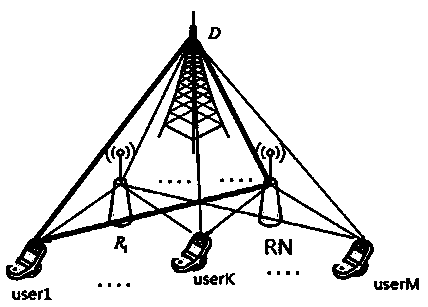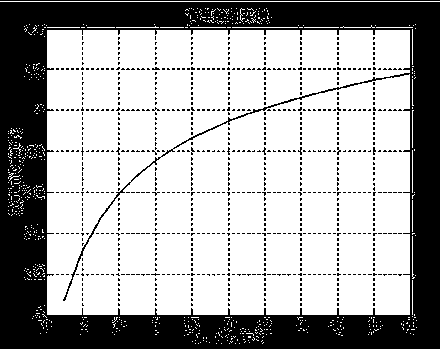Relay-node-number selection algorithm based on interruption probability in cellular-cell downlink
A downlink and cellular cell technology, applied in the field of relay technology, can solve the problems of unsuitable transmission of high-speed data and multimedia services, low spectrum utilization rate, poor anti-interference ability, etc., to reduce the probability of interruption and improve the system capacity , the effect of improving the utilization rate
- Summary
- Abstract
- Description
- Claims
- Application Information
AI Technical Summary
Problems solved by technology
Method used
Image
Examples
Embodiment Construction
[0026] The selection method and power allocation problem of the multi-user multi-relay optimal relay node number based on the outage probability in the cell downlink proposed by the present invention are described in detail as follows in conjunction with the accompanying drawings and the implementation process.
[0027] Such as figure 1 As shown, the system model of multi-user multi-relay in the cell downlink of the present invention, the specific selection of optimal relay node number and power allocation method includes the following steps:
[0028] Suppose there are K users and L relays in the cell;
[0029] Step 1: The base station and the user send pilot signals to all relays respectively. These two pilot signals are orthogonal to ensure that the relay can obtain channel state information from the base station to the relay and from the user to the relay without interference;
[0030] The transmission channel of the present invention adopts an orthogonal channel of two t...
PUM
 Login to View More
Login to View More Abstract
Description
Claims
Application Information
 Login to View More
Login to View More - R&D
- Intellectual Property
- Life Sciences
- Materials
- Tech Scout
- Unparalleled Data Quality
- Higher Quality Content
- 60% Fewer Hallucinations
Browse by: Latest US Patents, China's latest patents, Technical Efficacy Thesaurus, Application Domain, Technology Topic, Popular Technical Reports.
© 2025 PatSnap. All rights reserved.Legal|Privacy policy|Modern Slavery Act Transparency Statement|Sitemap|About US| Contact US: help@patsnap.com



